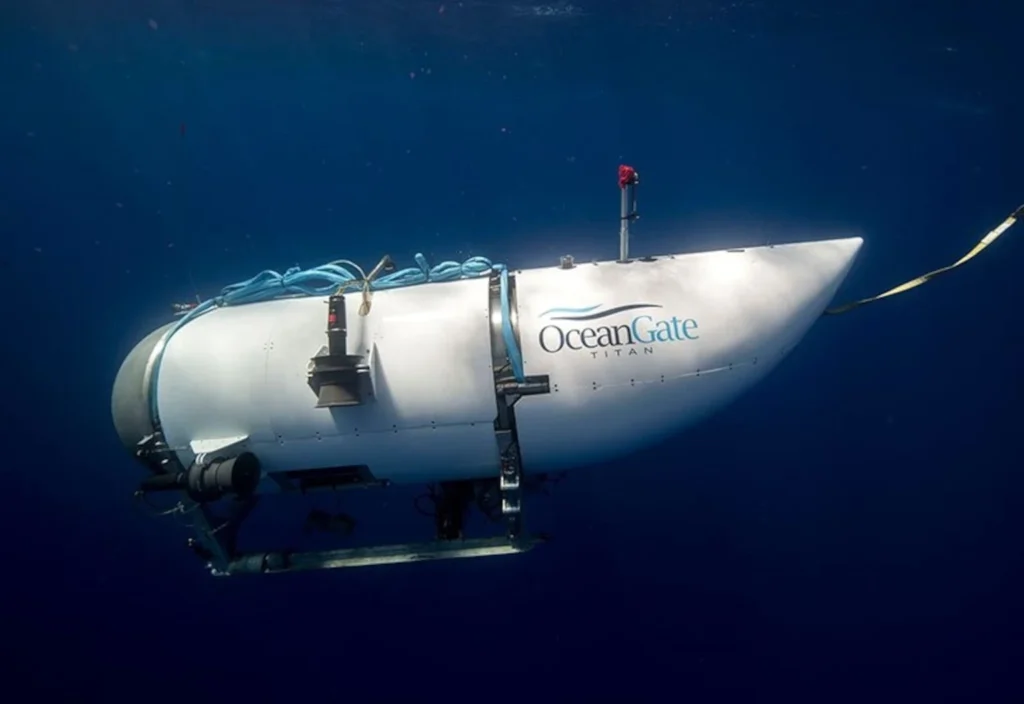Stockton Rush, CEO of OceanGate, once said in an interview, “There are three words in the English language which are known throughout the planet. That’s Coca-Cola, God, and Titanic.”
Stockton’s interest in the Titanic wreckage, which lays approximately 12,500 feet below the Atlantic Ocean, would see him create a business that allowed fellow history enthusiasts to visit the wreck.


He would build a submersible named Titan that took paying customers to the remains of the Titanic. The cost of a ticket was up to $250,000 per person.
On June 18, 2023, it turned out the cost was much greater than that: the expedition took the lives of the five people inside it while they were thousands of feet below the surface of the ocean.
The Beginnings Of OceanGate
Stockton Rush had grown up wanting to be an astronaut. His biggest dream was to be the first person on Mars. This lofty ambition didn’t fizzle out as Stockton got older. In fact, his desire to head into space only intensified.
He attended the prestigious Princeton University and graduated in 1984 with a degree in aerospace engineering, clinging to his dream of space exploration.
At one point, he worked as a flight test engineer for the F-15 fighter aircraft before moving to the Pacific Northwest in the late 1980s to run a company called “Remote Control Technology.” The business focused on creating radio-frequency wireless remote controls.
According to Stockton, he also built his own plane around this time. He allegedly flew his “two-seater experimental plane” numerous times over the years without incident.
After making the plane, Stockton was inspired to create something similar to explore the depths of the ocean. He was already a keen scuba diver, but his desire for exploration went further than that. Stockton wanted to go much, much deeper into the ocean, and only a submersible could do that.
Buying a submarine proved difficult for him. Not only did less than 100 people in the US own one, but none of them were willing to sell theirs.
So, Stockton decided to make his own smaller version of a submarine. He used Navy blueprints to create his submersible, which could reach depths of 33 feet.
Still, this wasn’t quite what Stockton was imagining. He wanted to prospect the unexplored depths of the ocean. Not only that, he wanted to create a business from this passion, selling tickets to those interested in diving to thousands of feet below sea level.
In 2009, Stockton Rush founded OceanGate for this very reason.
Stockton wasn’t quiet about his views on safety precautions when it came to his submersible venture. He would say, “If you just want to be safe, don’t get out of bed, don’t get in your car, don’t do anything. I think I can do this just as safely by breaking the rules.”
This quote would be an ominous foreboding of what was to come.
The Titan
Stockton, aided by various marine engineers, built a carbon fiber and titanium-hulled submersible named Cyclops.
After some tweaking with the design, OceanGate revealed the submersible had been renamed Titan and announced its intention to take passengers thousands of feet into the sea. The 22-foot, 23,000-pound vessel courted plenty of attention for its unique design.

Many people in the marine field voiced their concerns about Stockton’s design and questioned the submersible’s capabilities. Even those who’d worked with Stockton felt compelled to warn him of the sub’s dangers.
Rob McCallum had worked with Stockton in 2009, and when the Titan was announced in 2018, he emailed his former colleague. He warned the CEO that the Titan was going to face a similar fate as the ship they were visiting: the Titanic.
The Titanic, before its 1912 departure and subsequent sinking, was touted as “unsinkable.”
Stockton was making similar safety claims about the Titan, insisting OceanGate had a high level of safety processes in place. Stockton would assert that most marine failures and incidents are due to operational errors, not mechanical ones.
Still, this didn’t quell the criticism he was facing, not just from fellow marine enthusiasts but also from the public. Notably, many of OceanGate’s employees were recent graduates, which caused a sense of unease regarding the submersible’s engineering standards.
In 2022, Stockton offered the media a guided tour of the Titan, which caused further intrigue into his operation.
The inside was compact, and upon entering the vessel, Stockton pointed out the only toilet was attached to the door.
There were three monitors inside the sub and just one window just above the toilet. The vessel had no seats for its passengers, who would be seated on the floor throughout the excursion.
The tour exposed one of the more shocking aspects of the Titan’s build: the fact that it was controlled entirely by a modified video game controller.
The Deadly Descent
In total, the Titan made the trip to the Titanic three times since 2021. Prior to this, the sub also underwent multiple test dives. On June 18, 2023, the sub embarked on its third and last voyage to the Titanic wreckage.
Aboard the vessel were Stockton Rush, 58-year-old businessman Hamish Harding, 77-year-old Titanic enthusiast Paul-Henri Nargeolet, 48-year-old businessman Shahzada Dawood, and his son, 19-year-old Suleman Dawood.

At 8:00 am, the excited tourists were ready to board the submersible. It was launched from its mother ship named the “Polar Prince.”
The trip was supposed to take two and a half hours to reach the Titanic wreckage and the same time to return. The guests were told they’d have around three hours to explore the wreckage, meaning the entire trip should have lasted around eight hours.
For the first few hours, the Titan was making regular contact with the Polar Prince. However, by late morning, all contact ceased.
At the same time, the Navy detected something alarming on their acoustic detection system that was consistent with the implosion of a submersible.
Hours passed with no contact from the Titan. The expected return time for the crew came and went, with concerns becoming greater for the well-being of those on board. The Coast Guard was notified that evening, and a search was triggered for the Titan.
Almost two days after the Titan embarked on its voyage, sonars detected ominous banging noises coming from areas where the Titan was traveling.
These noises were unexplained, with some sources suggesting they could have been the Titan’s guests banging on the submersible walls to alert the Navy that they needed help.
In the meantime, it was widely reported that the group aboard the Titan only had 96 hours of oxygen before running out.
By the time the vessel’s disappearance made the news, only a few days’ worth of air was left. Some news outlets even created a crude “oxygen countdown” clock to show when the oxygen reached zero, suffocating all aboard.
As the public waited with bated breath, there was no news from the Coast Guard or the Navy. There was plenty of speculation, even from celebrities: James Cameron, director of the Titanic, also offered his view of what may have happened to the Titan.
Four days passed with no news. By this point, the oxygen countdown had reached zero.
The Coast Guard was using a remotely operated vessel to look for clues about what may have happened to the missing submersible. On June 22, it was announced that they’d found a debris field. They believed the Titan had imploded.
Despite the macabre news, it was thought that the implosion would have lasted less than a second, meaning those aboard would have died immediately, with no knowledge of what was about to happen to them.
Still, the way in which they died was brutal: their bodies were eviscerated by the overwhelmingly powerful implosion.
The tragic event left the families of the deceased and the public wanting answers. Notably, why did the Titan implode?
What Caused The Titan To Implode?
The Titan’s implosion has been called “catastrophic.” The big question lingering after the event was what caused the tragedy.
This question has no definite conclusion, though the vessel’s design has been touted as a major role in the submersible’s implosion. It was made from carbon fiber, a cheaper alternative to the stronger metal titanium. Carbon fiber is known to be volatile when dealing with compression.
Some speculators have suggested the acrylic viewing window on the sub could have triggered the implosion.

Then, there was the shape of the vessel. It was long instead of round, unlike most other submersibles. The circular shape of other vessels means that pressure underwater is distributed evenly. The Titan didn’t have this due to its oblong-shaped body.
The public quickly focused on the video game controller used to control the Titan. Although this didn’t contribute to the implosion, it highlighted the Titan’s lack of sophistication in its construction.
Other submersibles relied on a computerized system to steer the vessel; the Titan used an Xbox controller.
The news of the disaster caused a retrospective look into the Titan and Stockton Rush’s blasé attitude toward safety.
In the lead-up to the June 2023 tragedy, the Titan made several failed attempts to reach the Titanic, with some test trips highlighting issues with the thruster control and the onboard computers.
Some trips were so marred by failure that the submersible had to return to its mother ship, and the mission was aborted.
In an interview years before the Titan tragedy, Stockton Rush told journalists: “At some point, safety just is pure waste.”
Sources
https://edition.cnn.com/2023/06/21/business/stockton-rush-titanic-submersible/index.html













Leave a comment